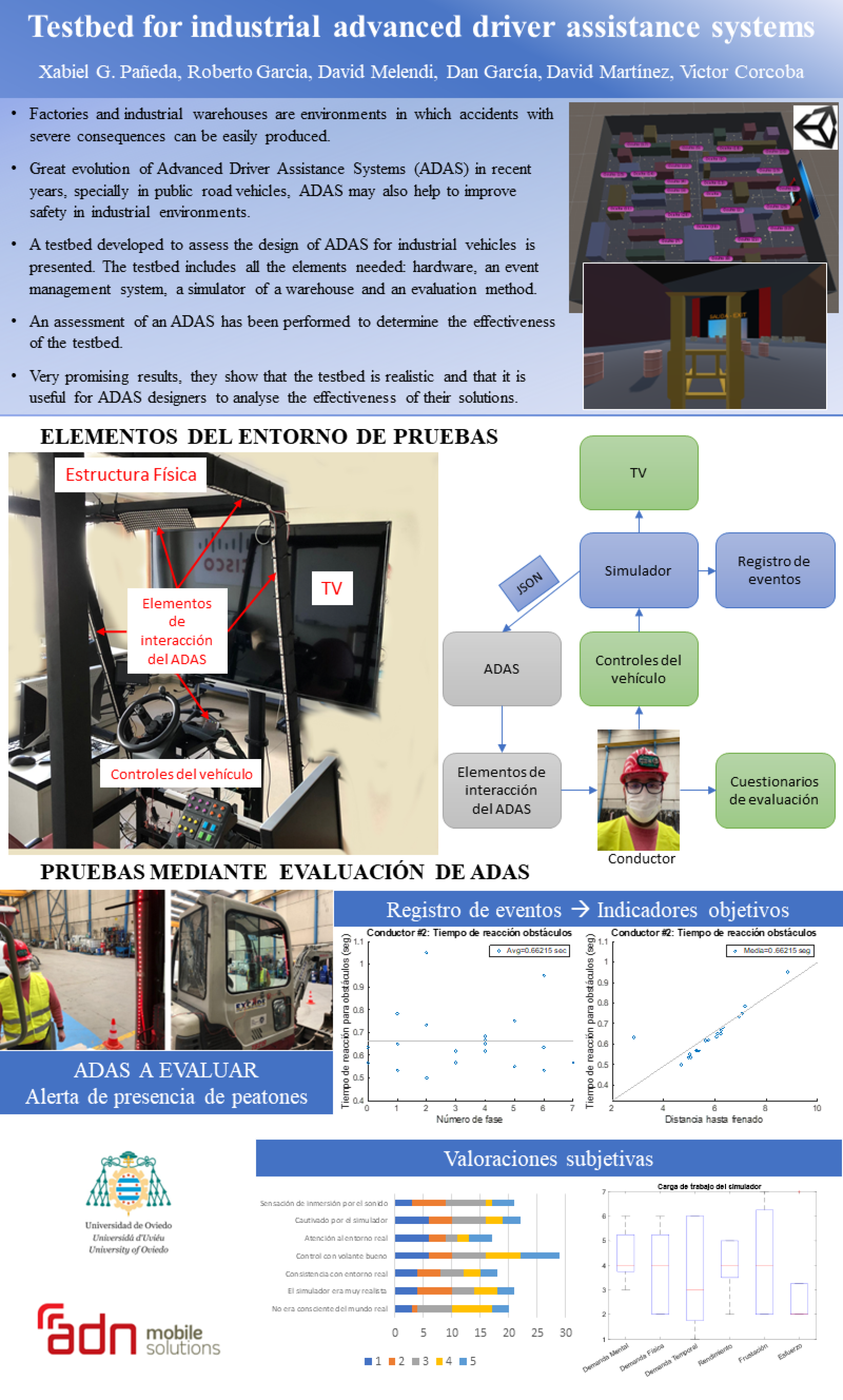Testbed for industrial advanced driver assistance systems
Keywords:
ADAS evaluation, driving assistance, industrial vehicles, intelligent transportation systems, testbedAbstract
Factories and industrial warehouses are environments in which accidents can be easily produced. People on foot work in the same place where heavy machinery is operating. Therefore, when accidents occur, they frequently have severe consequences. To reduce the number of accidents and their effects, there are strict regulations on the workplace and workers participate in regular training activities. In recent years, there has been a great evolution in Advanced Driver Assistance Systems (ADAS) specially in public road vehicles. With the proper design, these systems may also help to improve safety in industrial environments. For example, an ADAS may warn industrial drivers about nearby pedestrians. Nevertheless, the development of ADAS in this context is complex because industrial environments and their machines are very heterogeneous. Hence, this paper describes a testbed developed to assess the design of ADAS for industrial vehicles. The testbed includes all the elements needed to evaluate an industrial ADAS: hardware, an event management system, a simulator of a warehouse and, an evaluation methodology. To determine the effectiveness of the testbed, the assessment of an ADAS designed to warn industrial drivers about nearby obstacles has also been performed. The assessment includes a subjective evaluation of the testbed and of the cognitive load generated during the evaluation. The results of this assessment are very promising. They show that the testbed is realistic and that it is effective for ADAS designers to analyse the reactions of drivers to the signals produced by the assistance systems under evaluation.
Downloads
References
T.J. Larsson, T. Horberry, T. Brennan, J. Lambert, I. Johnston, “A Guidebook of Industrial Traffic Management and Forklift Safety”, Monash University Accident Research Centre Guidebook, Australia, 2003.
Occupational Safety and Health Administration (OSHA), “OSHA Fatality and Catastrophe Investigation Summaries”, 2023, [Online] Disponible en: https://www.osha.gov/pls/imis/accidentsearch.html.
R. Bostelman, “Towards improved forklift safety: white paper,” 9th Workshop on Performance Metrics for Intelligent Systems, 2009.
D.P. Upahita, Y.D. Wong, K.M. Lum, “Effect of driving inactivity on driver’s lateral positioning control: A driving simulator study”, Transportation Research Part F: Traffic Psychology and Behaviour, vol. 58, pp. 893-905, Oct. 2018.
M. P. Bobermin, M. M. Silva, S. Ferreira, “Driving simulators to evaluate road geometric design effects on driver behaviour: A systematic review”, Accident Analysis & Prevention, vol. 150, Feb. 2021.
L. M. Martín-delosReyes, E. Jiménez-Mejías, V. Martínez-Ruiz, E. Moreno-Roldán, D. Molina-Soberanes, P. Lardelli-Claret, “Efficacy of training with driving simulators in improving safety in young novice or learner drivers: A systematic review”, Transportation Research Part F: Traffic Psychology and Behaviour, vol. 62, pp. 58-65, Apr. 2019.
A. Karimi, M. Bassani, AM. Boroujerdian, L. Catani, “Investigation into passing behavior at passing zones to validate and extend the use of driving simulators in two-lane roads safety analysis”, Accident Analysis & Prevention, vol. 139, May 2020.
S. Marchesiello, Y. Noda, R. Hoshi, A. Kaneshige, “Training Simulator for Acquiring Operational Skill to Operate Overhead Traveling Crane while Suppressing Load Sway”. Shock and vibration, vol. 2019, May 2019.
K. Dhalmahapatra, J. Maiti, O.B. Krishna, “Assessment of virtual reality based safety training simulator for electric overhead crane operations”, Safety Science, vol. 139, Jul. 2021.
M. Choi, S. Ahn, J. O. Seo, “VR-Based investigation of forklift operator situation awareness for preventing collision accidents”, Accident Analysis & Prevention, vol. 136, Mar. 2020.
M. Ulrich, C. Marbach, C. Dolar, C. Engelha, “Collision Warning System for Forklift Trucks”. ATZ Heavy Duty Worldwide, vol. 13, pp. 16-21, 2020.
L. Cao, T. Depner, H. Borstell, K. Richter, “Discussions on sensor-based Assistance Systems for Forklifts,” Smart SysTech 2019; European Conference on Smart Objects, Systems and Technologies, pp. 1-8, 2019.
A. M. v. Stein, A. Dorofeev, J. Fottner, “Visual collision warning displays in industrial trucks”, IEEE International Conference on Vehicular Electronics and Safety (ICVES), pp. 1-7, 2018.
T. G. Bobick, M. Hause, C. Socias-Morales, M. Gwilliam, D. Tashira. “Forklift Safety: A Pilot Study Evaluation of Retrofit Lights.” Prof. Safety, vol. 65, no. 12, pp. 41–45., Dec. 2020.
R. S. Kennedy, N. E. Lane, K. S. Berbaum, M. G. Lilienthal, “Simulator Sickness Questionnaire: An Enhanced Method for Quantifying Simulator Sickness”, Int. J. Aviat. Psychol., vol. 3, no. 3, pp. 203-220, Jul. 1993.
R. Reinhar, H. M. Rutrecht, P. Hengstenberg, E. Tutulmaz, B. Geissler, H. Hecht, A. Muttray, “The best way to assess visually induced motion sickness in a fixed-base driving simulator”, Transp. Res. Part F Traffic Psychol. Behav., vol. 48, pp. 74-88, Jul. 2017.
A. Helland, S. Lydersen, L.-E. Lervåg, G. D. Jenssen, J. Mørland, L. Slørdal, “Driving simulator sickness: Impact on driving performance, influence of blood alcohol concentration, and effect of repeated simulator exposures”, Accid. Anal. Prev., vol. 94, pp. 180-187, Sep. 2016.
T. Schubert, F. Friedmann, H. Regenbrecht, “The experience of presence: Factor analytic insights”, Presence Teleoperators Virtual Environ., vol. 10, no. 3, pp. 266-281, Jun. 2001.
H. M. Sun, S. P. Li, Y. Q. Zhu, B. Hsiao, “The effect of user’s perceived presence and promotion focus on usability for interacting in virtual environments”, Appl. Ergon., vol. 50, pp. 126-132, Sep. 2015.
J. Brade, M. Lorenz, M. Busch, N. Hammer, M. Tscheligi, P. Klimant, “Being there again – Presence in real and virtual environments and its relation to usability and user experience using a mobile navigation task”, Int. J. Hum.-Comput. Stud., vol. 101, pp. 76-87, may 2017.
S. G. Hart, L. E. Staveland, “Development of NASA-TLX (Task Load Index): Results of Empirical and Theoretical Research”, Advances in Psychology, vol. 52, pp. 139-183, 1988.
M.J. Crawley, “The R Book”, John Willey & Sons, Ltd, 2007.


